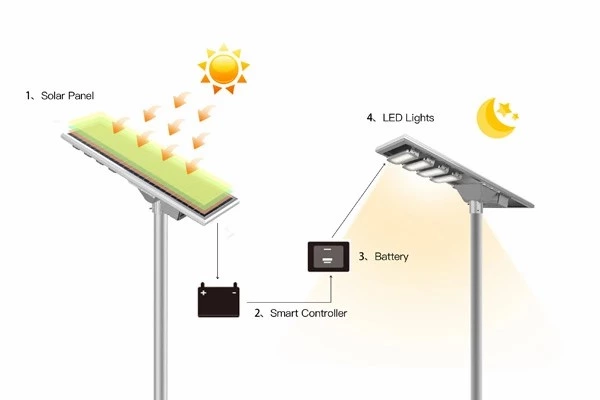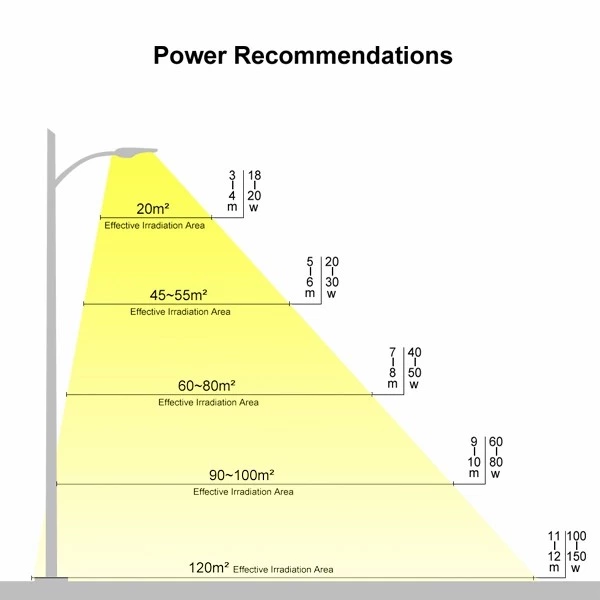Why Choose US
We have always been dedicated to promoting the development of solar street lights.

In today's urban lighting, Solar Street Lights stand out for their eco-friendliness and efficiency are revolutionizing our approach to environmental sustainability.
This guide simplifies the selection of solar lighting solutions, highlighting their benefits in reducing grid dependence and energy costs. Explore the essentials of solar-powered lighting and their role in sustainable urban development
The core components of solar street lights are solar panels, batteries, solar controllers, light sources, and often motion sensors. Their working principle involves solar panels absorbing sunlight during the day and converting it into electrical energy. This energy is then stored in batteries for nighttime use. This independent power supply method significantly reduces reliance on the traditional power grid, while also substantially lowering energy costs.
The advantages of solar lighting are:
For more detailed information about solar lights, refer to the Complete Guide to Solar Lighting Fixtures.

To build a long-term stable solar lighting system, its size must be appropriate, with a focus on reliability. To ensure the system operates stably under all weather conditions throughout the year, the energy collected and stored by the batteries must always exceed the energy required to light up the lamps, even under the worst conditions. Next, we explain the energy path in the operation of solar lighting fixtures.
1. Sun and Solar Panels
Solar panels are responsible for converting sunlight into electrical energy. These panels are made up of multiple silicon cell units and can work effectively even in low-light environments. Their most significant feature is their ability to adapt to varying climatic conditions, maintaining a stable energy supply.
The efficiency of the panels, the ability to convert solar energy into electrical energy, is the core measure of their performance. High-efficiency panels on the market today can typically achieve conversion rates of about 15%, a significant improvement over earlier products. This progress means that modern solar street lighting systems are more efficient in providing continuous, reliable energy.
2. From Solar Panels to the Energy Management System
When solar panels convert light energy into electrical energy, the Energy Management System (EMS) ensures that this energy is safely stored and efficiently transmitted to the LED lighting fixtures of the street lights.
The EMS mainly includes two core components:
Different manufacturers have various designs for the EMS. Some systems integrate the charge controller with the LED driver to maximize energy usage efficiency. Others separate these two components to increase the system's adaptability and flexibility. Although this design may slightly sacrifice some efficiency, for example, the energy efficiency might drop to 85%, it allows for targeted maintenance and upgrades.
3. Battery
The battery is responsible for storing the electrical energy managed by the EMS and powering the LED lighting at night. The battery's capacity must match the customer's specific requirements based on lighting needs. For example, systems designed for all-night lighting need larger capacity batteries to ensure continuous power supply.
The charge controller plays a key role in battery maintenance. It not only ensures the battery is adequately charged but also prevents overcharging and overheating, ensuring battery safety and lifespan. In addition, the charge controller prevents reverse current flow between the solar panels and the battery.
We will explore various types of batteries and their application scenarios in more detail below.
1. Battery
In energy output, the battery is responsible for powering LED lighting and other systems.
2. LED Fixtures
LED fixtures are the preferred choice for solar lighting systems due to their energy-saving and stable characteristics. The common brightness of LEDs on the market ranges from 60-120 lumens per watt. It's important to note that when selecting LED fixtures, overall performance testing data such as TM-21 and LM-80 reports should be considered. These reports help assess the brightness of the entire fixture, not just individual LED beads.
With the continuous advancement of LED technology, it's now possible to achieve brighter lighting with lower power consumption, thereby reducing production costs and indirectly improving the cost-effectiveness of the entire lighting system.
The design and functionality of solar-powered street lighting vary by type, each suitable for different applications and environments. Understanding these types helps in identifying the right purchase for different buyers.

This all in one solar street light design incorporates solar panels, LED lights, batteries, and controllers into a single unit, offering a compact solution. Ideal for urban streets, parks, and residential areas requiring 10-30 feet of lighting height. Price ranges from moderate to high, depending on the quality and efficiency of the components.
Known for their distinct separation between LED lights and solar panels, these allow the use of larger panels (usually 2-3 times the size of integrated lights, such as 50-200 watts) to illuminate areas within 50 to 200 feet. Primarily used in squares and busy roadways, they provide extensive and uniform lighting. While more costly, their effectiveness makes them ideal for large public spaces.
In these systems, solar panels and light fixtures are independent, offering greater flexibility in installation. Especially suited for areas requiring specific lighting angles or having obstructions. For regions needing all-night lighting, split systems can be equipped with larger capacity batteries, generally 1.5 to 2 times that of all in one solar street lights.
The efficiency and quality of the panels are paramount as they are the energy gateway.
Monocrystalline Panels
Efficiency: 17%-22%, among the highest in the market.
Features: High efficiency means more power from less area, ideal for space-constrained yet high-efficiency demands.
Suitable Buyers: High-end project developers and brand clients focusing on long-term performance and reliability.
Polycrystalline Panels
Efficiency: 15%-17%, slightly lower than monocrystalline but more cost-effective.
Features: Cost-effective, suitable for large-scale installations.
Suitable Buyers: Budget-sensitive clients, material supermarkets, and traders looking for cost-effective products.
Thin-Film Solar Panels
Efficiency: 10%-13%, ideal for low-light conditions.
Features: High flexibility, can bend, suitable for non-standard surfaces.
Suitable Buyers: Innovative businesses or special application projects requiring unique designs or flexible installation.
The stability of solar street lighting largely depends on the capacity and lifespan of the batteries, especially critical in regions with shorter daylight hours, such as London and Seattle.
Calculating Battery Capacity
For example, a 60-watt solar street light operating for 6 hours per day would consume 360WH daily. To ensure lighting during three consecutive days of rain, a minimum of 1080WH is required. Using an 11.1V lithium-ion battery, the capacity needed is approximately 97.2AH (1080WH/11.1V ≈ 97.2AH).
Types of Batteries and Their Features
LED beads are crucial in solar street lights, directly affecting their performance and lifespan. High-quality LED beads offer excellent heat dissipation, brightness, and stability.
Types of LED Chips
| LED Chip Type | Luminous Efficiency | Features |
|---|---|---|
| 2835 LED Chip | 150 lm/W | Ideal for projects requiring high lumen output, excellent light efficiency, and reliability. |
| 3030 LED Chip | 130 lm/W | 3030 chips are primarily used in street lights and floodlights. |
| 5050 LED Chip | 150-160 lm/W | Large surface area, strong heat dissipation, perfect for long-term use in harsh outdoor conditions. |

Specifications of Different LED Chips
The role of Protection Levels (IP)
The Ingress Protection (IP) rating is a key indicator in assessing the ability of solar street lights to withstand harsh weather conditions. It mainly measures the level of resistance to solid objects (like dust) and water. Generally, the higher the IP rating, the better the electrical safety maintenance and longer product lifespan.
Common IP Ratings for Solar Street Lights
The height of poles for solar-powered street lighting typically ranges from 9 to 23 feet, and choosing the right material is crucial for ensuring their durability and functionality.
Common Lamp Post Materials
Features: Economical and heavy. Usually treated with galvanization and painting to enhance rust resistance.
Lifespan: Typically 5 to 8 years, matching the operational life of many solar-powered street lighting systems.
Suitable for: Budget-limited projects where weight is not a primary concern.
Features: Known for good rust and corrosion resistance, usually treated with hot-dip galvanizing.
Lifespan: Up to 15 years, lighter than iron poles but more costly.
Suitable for: Long-term and high-standard engineering projects.
Features: Durable and aesthetically pleasing, made from high-strength aluminum alloy, resistant to corrosion for over 50 years without additional surface treatment. Cost is about 6 times that of iron street lights.
Suitable for: High-end projects focusing on appearance and long-term durability, such as park and courtyard lighting.
One of the design focuses of solar street lights is energy efficiency. Based on the use of solar energy, various energy-saving features are usually integrated, which not only improve energy utilization rates but also reduce unnecessary power consumption.
Solar street lights can automatically adjust their brightness to suit different environmental conditions. For example, at night when pedestrian traffic is sparse, the lights can automatically reduce brightness to save energy.
Motion sensors detect activity in the vicinity, automatically enhancing brightness when people or vehicles are detected. This intelligent adjustment not only saves energy but also enhances the practicality and safety of the street lights.
Solar street lights can be equipped with timing systems to automatically turn on and off during the most commonly used time periods. This setting is particularly suitable for areas with low night-time traffic.
Using high-efficiency LED fixtures is also key to energy saving. Modern LED technology provides high brightness while significantly reducing energy consumption.
Conducting a detailed demand analysis is crucial for ensuring project success. Consider the following factors:
Selecting the right suppliers and manufacturers is key to ensuring project quality and long-term reliability.
Proper installation and regular maintenance are key to ensuring the long-term stable operation of solar street lights.
— YH0103A
Features: Designed with an industrial mechanical feel, this die-cast aluminum integrated led solar street light has an IP65 rating. Equipped with a DC direct current interface, it can effectively supplement power even in low sunlight, ensuring stable lighting. Built-in light sensor control and timing control for intelligent energy saving.
Configuration: Equipped with high-efficiency LED fixtures and monocrystalline solar panels, MPPT controller.
Advantages: Combining unique design and technology, it provides first-class lighting effects and energy efficiency for urban streets.
— YH0103
Features: Mechanical-feel ABS integrated solar led street lights, combining cost-effectiveness and practicality. Similar to YH0103A, equipped with a DC interface and MPPT controller, maximizing battery efficiency.
Configuration: High-efficiency LED fixtures and monocrystalline solar panels, MPPT smart controller, long-life lithium iron phosphate battery.
Advantages: Suitable for parks and courtyards requiring high cost-effectiveness and attractive appearance.
— YH0101A
Features: Flexible split design, equipped with a large-capacity battery for extensive and uniform lighting. Made of durable die-cast aluminum with IP65 protection, features timing control and adaptive brightness control.
Configuration: Large-capacity lithium iron phosphate battery and monocrystalline solar panel.
Advantages: Covers a large area, suitable for parking lots, warehouse peripheries, and commercial facilities.
YINGHAO offers comprehensive customization for each solar street light model to meet your specific requirements.
With our in-house solar panel production workshop and strict quality control processes, YINGHAO is committed to providing high-standard, high-quality solar street light products. Our stringent delivery standards ensure that each street light meets the highest quality benchmarks.
As we conclude this guide on Solar Street Lights, we see a clear vision of their role in creating sustainable and efficient urban environments. Yinghao is committed to contributing to this evolving field with our range of solar street lighting solutions. Our focus is on providing eco-friendly, cost-effective lighting options that cater to the diverse needs of modern urban spaces.
Join us on this journey towards a greener future, and explore how Yinghao's solar lighting solutions can be a part of your sustainable urban development.
For more insights or to engage with our products, we invite you to reach out to us.
We are available from Monday to Friday
8:30-18:00
YINGHAO
Street: Liande 69
City: Guangdong Province, Zhongshan
ZIP code: 528414
Country: China
This website uses anonymous performance cookies to ensure you get the best experience on our website. We never use targeting or advertising cookies.
Please click here to view our cookie policy.